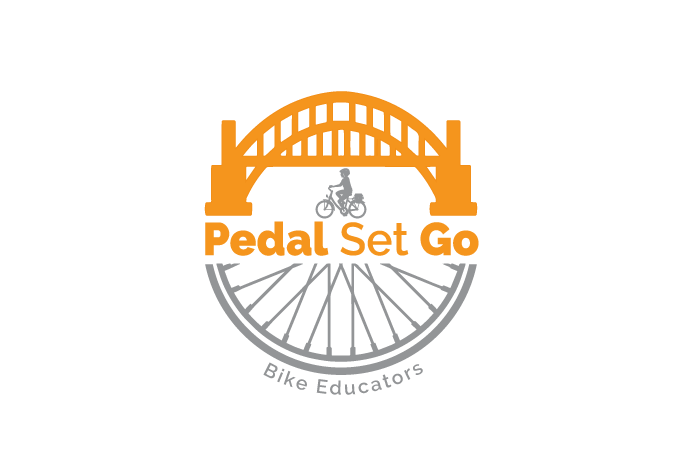Teaching a child to ride a bike
Teaching a child to ride a bike can be an exciting and memorable experience. Here's a step-by-step, Ummm…Pedal… guide to help you teach a child to ride a bike: At Pedal Set Go we do NOT recommend training wheels, with the exception being for some people with disability. The same techniques can be used when teaching an adult to learn to ride a bicycle.
Choosing the Perfect Bike: Setting the Foundation for Riding Success
Ensure that the child has a bike that they can sit on comfortably with their feet flat when touching the ground. At this stage, a bike is better slightly too small rather than too large. The learner will not feel safe nor confident if they are on their tip-toes. Pedal Set Go do not encourage people to purchase a bike their child will “grow into.”
Ensure your child has the right bike for a comfortable and confident start.
Selecting a Safe Riding Location in Sydney: Where to Begin
Discover the ideal spots in Sydney for teaching bike riding, prioritising safety and space. Look for a spacious and flat area with a smooth surface, such as netball or basketball courts, a quiet street, or an empty car park. Avoid busy roads or areas with heavy traffic.
Prepping the Bike: Removing Pedals and Adjusting the Seat for Optimal Learning
Step-by-step guide on pedal removal and saddle adjustment to facilitate the initial learning phase.
Start by removing the pedals from the bike. A number 15 spanner will suffice if you do not have a pedal wrench. The left and right pedals are threaded in opposite directions. The right pedal is threaded normally – turn counterclockwise to loosen. The left pedal is threaded in reverse – turn clockwise to loosen. Lower the saddle so that the child can easily place their feet flat on the ground while sitting on the seat. Lower is best, and ideally, the child can spread their legs and feet apart like a tripod. (If there are no markings on the pedals, you may want to label them left and right.)
Building Balance and Confidence: The Gliding and Balancing Technique
Learning to glide and balance: Begin by helping the child learn to balance on the bike without pedals. If the bike has a hand brake lever or levers, encourage them to use the brakes while getting on and off the bike. Show them how to use the brake rather than their feet to slow or stop the bike. Have them mount the bike and walk while sitting on the seat, using their feet to stabilise themselves. Remind them to remain seated. Encourage them to keep their eyes focused straight ahead and their arms relaxed. When moving in a straight line or steering, the bike will follow their gaze.
Learn how to guide your child through gliding and balancing exercises to foster confidence.
Mastering the Art of Gliding: Scooting to Develop Balance and Momentum
Once the child is comfortable walking, encourage them to push off the ground with their feet and start scooting. They should lift their feet off the ground and try to glide for short distances. Practise this scooting and gliding technique to help them build momentum and develop a sense of balance. Remember, just like a rolling coin, the bike needs some momentum to stay upright.
Explore techniques for scooting and gliding, essential for building momentum and balance.
From here, it should be fun, and apart from reminding the child to look where they want to go, there is not much more for the adult to do. The child will learn through play and experience. Every wobble and false start is a lesson in the right direction. Little and often also avoids the risk of a sore bum.
Pedals Back On: Transitioning to Pedalling with Confidence
Reinstall the pedals once your child has gained confidence in gliding and balancing. Once the child can demonstrate consistent balance through gliding and steering, reattach the pedals to the bike. Make sure they are properly threaded.
A comprehensive guide to instructing your child to pedal and maintain momentum.
Pedal Set...Go!: Teaching the Basics of Pedalling
First, remind the child about the importance of brakes and ask them to demonstrate how they will stop the bike with the brake levers or back pedal brake. Instruct the child to set the pedal to 2 o’clock with one foot on the pedals, and after a big push, lift their other foot onto the other pedal. Continue pedalling to maintain momentum. Encourage them to keep pedalling so they can maintain momentum and their balance. You may wish to support them briefly, but allow the child to practice pedalling independently as much as possible.
Practice Makes Perfect: Building Skills and Confidence Through Repetition
Encourage regular practice, gradually raising the seat as your child gains control. Introduce more challenging terrain as their confidence and skills improve.
Positive Reinforcement: Celebrating Achievements and Nurturing Confidence
Praise the child for their efforts and progress. Celebrate their successes, no matter how small. Positive reinforcement will boost their confidence and motivation and ensure the activity remains fun.
Remember, every child learns at their own pace, so be patient and supportive throughout the process. With time and practice, most children—in fact, people of all ages—can learn to ride a bike independently.






